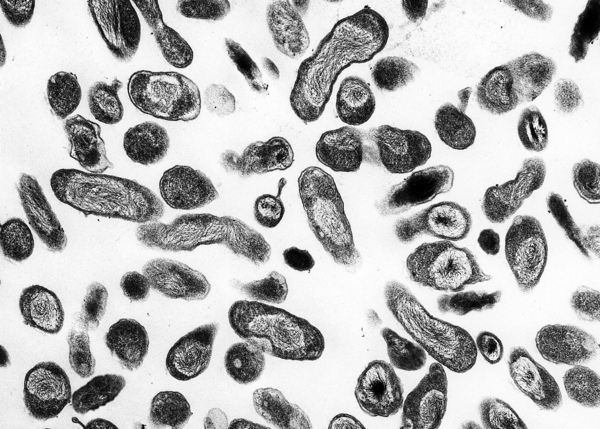上次有簡單介紹過一下Q fever:Q熱(Q fever)
現在連講點比較仔細的:
直接從病源方面介紹:Coxiella burnetii 
MICROBIOLOGY
Small, obligate intracellular gram-negative bacillus.
Excreted from feces, urine and milk of infected animals.
Organisms are hardy.
Can survive in environment as resistant to heat, desiccation and often disinfectants.
CLINICAL
Epidemiology: global zoonosis, rare in the U.S.
Primary reservoirs: cattle, sheep and goats most commonly implicated. Less common: cats, dogs, arthropods.
Acquisition: mammals (usually asymptomatic) shed C. burnetii in stool, urine, milk, birth products. Highest bacterial loads seen in placenta. Acquired by inhalation, often from dust contaminated by infected feces or birth material. Tick-borne and human-human transmission rarely described.
Occupational risk: farmers, vets, abattoir workers, lab workers.
Diagnosis: serology (IFA) 1) acute disease (pneumonia) show seroconversion or anti-phase II Ab, 2) chronic anti-phase I Ab. PCR (blood, heart valve) is 60% sensitive and 100% specific. Immunohistochemistry, PCR or cell culture techniques can also be used.
Reportable infection in U.S.; bioterrorism category B agent.
Other abnormalities: thrombocytopenia, valvular vegetations.
SITES OF INFECTION
Asymptomatic (60%)
Acute: Flu-like illness, pneumonia (typical or atypical presentations or FUO w/ "incidental" pneumonia), or hepatitis
Chronic: endocarditis (90% pts have prosthetic valve or other pre-existing cardiac abnormality, other groups at risk include those with immunosuppression, e.g., transplant pts, active malignancy)
Chronic, other: pneumonia (FUO w/ "incidental" pneumonia), hepatitis, rare-pericarditis, myocarditis, aseptic meningitis, osteomyelitis, chronic fatigue
Risks for chronic infection: prosthetic valve and immunosuppression
Many cause chronic (post-infectious) fatigue syndrome and travel related FUO (rare) .
TREATMENT
Antibiotic regimens
--------------------------------------------------------------------------------
Active in vitro: tetracyclines, macrolides, TMP-SMX, rifampin, fluoroquinolones.
Inactive: ß-lactams, aminoglycosides.
Acute pneumonia (ATS/IDSA guidelines, CID 2007;44:S27): doxycycline 100mg PO or IV twice daily x 14-21 days.
Alternative: macrolide + rifampin or fluoroquinolone (levofloxacin or moxifloxacin).
Hepatitis: doxycycline 100mg PO twice daily x 2 wks (duration arbitrary).
Endocarditis (Karakousis, et al, JCM 2006;44:2283): doxycycline 100mg PO or IV twice daily + chloroquine 200mg PO three times a day x >18mos (indefinitely or until phase I IgG <1:200, Raoult CID 2001;33:312). Some recommend treating >3 years (Levy AAC 1991;35:533).
OTHER INFORMATION
Occupational disease from cattle, goat, sheep; also parturient cats
Dx is serology w/ evidence of seroconversion (pneumonia) or high titers (endocarditis).
Main forms: "atypical pneumonia" (multilobar consolidation), nonspecific fever and endocarditis.
Chronic endocarditis usually is prosthetic valve endocarditis. Chronic infection often w/ "autoimmune" phenomenon, e.g., rash, (+) rheumatoid factor, Coombs' test (+).
Basis for Recommendations
Mandell LA, Wunderink RG, Anzueto A, et al.; Infectious Diseases Society of America/American Thoracic Society consensus guidelines on the management of community-acquired pneumonia in adults.; Clin Infect Dis; 2007; Vol. 44 Suppl 2; pp. S27-72;
ISSN: 1537-6591;
PUBMED: 17278083
Rating: Basis for recommendation
Comments:Used for Q fever pneumonia recommendations.
Karakousis PC, Trucksis M, Dumler JS; Chronic Q fever in the United States.; J Clin Microbiol; 2006; Vol. 44; pp. 2283-7;
ISSN: 0095-1137;
PUBMED: 16757641
Rating: Basis for recommendation
Comments:Review of 7 US cases of prosthetic valve endocarditis with farm exposure (5), male sex (7), phase I IgG elevated (7), aortic valve involvement (7) and treatment with valve replacement (4).
Fenollar F, Fournier PE, Carrieri MP, et al.; Risks factors and prevention of Q fever endocarditis.; Clin Infect Dis; 2001; Vol. 33; pp. 312-6;
ISSN: 1058-4838;
PUBMED: 11438895
Rating: Basis for recommendation
Comments:The authors review 102 cases of Q fever endocarditis in France. Of these 95 (93%) had predisposing valve disease. The abx regimen advocated with doxycycline + chloroquine for 12 mo w/ follow-up serology q 3 months for the next 2 yrs. The risk of Q fever endocarditis in those with acute Q fever + a predisposing valve lesion was 39%.
Marrie T ; Coxiella burnetii ; Chapter 177 IN: Principles & Practice of Infectious Disease, 5th Ed, Mandell G, Bennett J, Dolin R, Churchill Livingstone, 2000, pg 2043 ; 2000 ; Vol. 2043 ;
Rating: Basis for recommendation
Comments:The author, noted for his experience with Q fever pneumonia, summarizes the various forms of Coxiella burnetii infection. The pneumonia has 3 forms - "typical", atypical pneumonia, fulminant pneumonia, or FUO with pneumonia as an incidental finding. The dx is serology and the treatment is doxycycline.
資料來源:Abx guide 2009-07





 留言列表
留言列表
 線上藥物查詢
線上藥物查詢 